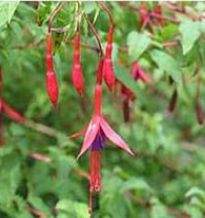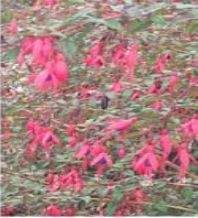
Fuchsia magellanica
FUCHSIA MAGELLANICA
Fuchsia magellanica – When other Fuchsia fail to survive in the Winter, this robust species from South America can be relied upon to retain a framework of branches. The purple and red flowers are small but borne profusely throughout the summer.
This plant succeeds in any well-drained soil and prefers partial shade to full sun. A very ornamental plant, it is a parent of many of the hardy ornamental Fuchsia varieties.
It can grow to a height of 2m. Fuchsia magellanica flowers from July to October. Fuchsia can work really well in a mixed hedgerow.



Hyland’s Nursery Price List – Fuchsia Magellanica
Prices listed above are for collection from Hyland’s Nursery in Oulart. For more information please visit our terms & conditions page.
Type of Fuchsia plants you can buy and when to plant them
Pots or containers:
Fuchsia in pots can be planted all year round and can be any size, from a plant in a 9cm pot to a plant in a large tub. Their root is settled into the pot and the plant has been actively growing in the pot thus it is well established. A plant in a pot can be sown all year round. As it is established in the pot, there is little disturbance to the plant when planted into the ground so it is more likely to grow. It is seldom that a plant in a pot fails unless the watering conditions haven’t been correct. It will need to be watered in well when initially planted. If planted during a hot time or in the summer, it may need to be watered a few times a week until they get established in the ground.
Planting tips
Distance apart:
Smaller plants should be planted at a distance of 30-50cm apart in a single row. Larger plants won’t need to be planted as close, but how close will depend on how soon you want your hedge to look full.
Preparation before planting:
The ground should be clean and free from weeds and grass. This gives the new plants a good chance to get established. If the area you are going to plant them in has grass or weeds, the ground should be sprayed off a week or so before planting to avoid any competition. To help prevent too many weeds appearing after you have planted your hedge, I find it a good idea to put your grass clippings or mulch around the plants as this smothers out the weeds and helps prevent the plants drying out.
Depth:
The plants should be planted deep enough to cover the roots. They do not like to be planted too deep as this may kill them or stunt their growth.
Fuchsia doesn’t like to be lying in water so if the area you want to plant them in is wet, you may need to consider draining the ground or making a mound/ditch of top soil on top of the ground and plant them into this.
Fuchsia prefers partial shade to full sun.
Aftercare:
Once the Fuchsia is established you can trim it once a year. Spring or late summer is a good time to give it a trim as it flowers throughout the summer. It shouldn’t be trimmed if the weather is really hot and dry. You can give your hedge a feed of any high nitrogen feed (e.g. in the nursery we use 18-6-12) or poultry manure pellets in late spring/early summer.
General problems with Fushia hedges
Yellow leaves:
When the leaves turn yellow and fall off this may be caused by lack of water or too much water.
Lack of water (drought):
Fuchsia is quite tolerant to dry conditions. If you have a newly planted hedge that is turning yellow and is losing its leaves, it is generally not getting enough water. It should not be let get too dry in the first year. If planted in a dry time you will need to water it in well and water it once a week- weather dependant.
Too much water (waterlogged):
If you have a more established hedge and it starts turning yellow, the ground may be water logged. Laurel doesn’t like sitting in water for a long period of time.
Stress:
If you have planted large hedging, if your water conditions are correct, it may be the plant reacting to its change of environment or the weather conditions and is under a little stress, but once it gets going it should be ok.
Hunger:
Another reason for your leaves turning yellow is hunger and your hedge may need a granule or liquid feed with high nitrogen or some poultry manure pellets.
If you have any questions, please do reach out to us by phone +353 87 277 3492 or email for answers.









